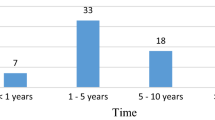Abstract
Chronic otits media (COM) is surgically treatable disease which includes complete removal of disease and improving hearing via ossicular reconstruction. Therefore, thorough assessment of the disease, ossicles and various factors causing it plays a major role in surgical outcome prediction. MERI (Middle ear risk index) is one such tool being used worldwide. Our aim was to evaluate the surgical outcome of tympanomastoid surgery using MERI and find out correlation between them as well as categorize cases into their severity score in a developing country. Observational prospective study conducted in a tertiary care center. 200 patients were included. After complete history and examination, they were given MERI scores and prediction of surgical outcome was done. Postoperatively it was compared with the real outcome of the surgery. Out of 200 patients, 71.5% had mild, 15.5% had moderate and 13% had severe MERI scores preoperatively. There was a success rate of 88.5% in graft uptake and the mean score of hearing benefit (A-B gain) among patients was 8.75 ± 8.82 dB postoperatively. MERI may be used as a prognostic indicator for predicting surgical outcome. Based on the MERI score, chances of surgical success and hearing benefit can be explained to the patient with certain limitations.

Similar content being viewed by others
References
Sergi B, Galli J, De Corso E, Parrilla C, Paludetti G (2011) Overlay versus underlay myringoplasty: report of outcomes considering closure of perforation and hearing function. Acta Otorhinolaryngol Ital 31(6):366–371
Kartush JM (1994) Ossicular chain reconstruction. Capitulum to malleus. Otolaryngol Clin North Am 27(4):689–715
Becvarovski Z, Kartush JM (2001) Smoking and tympanoplasty: implications for prognosis and the middle ear risk index (MERI). Laryngoscope 111(10):1806–1811
Jose Acuin. Chronic suppurative otitis media Burden of Illness and Management Options. World Health Organisation; 2004. Child and Adolescent Health and Development Prevention of Blindness and Deafness. https://apps.who.int/iris/handle/10665/42941
Basak B, Gayen GC, Das M, Dhar G, Ray R, Das AK (2014) Demographic profile of CSOM in a rural tertiary care hospital. IOSR J Pharm 4(6):43–46
Andersen SA, Aabenhus K, Glad H, Sørensen MS (2014) Graft take-rates after tympanoplasty: results from a prospective ear surgery database. Otol Neurotol 35(10):e292–e297
Mohammadi G, Naderpour M, Mousaviagdas M (2012) Ossicular erosion in patients requiring surgery for cholesteatoma. Iran J Otorhinolaryngol 24(68):125–128
Wilson KF, London NR, Shelton C (2013) Tympanoplasty with intact canal wall mastoidectomy for cholesteatoma: long-term hearing outcomes. Laryngoscope 123(12):3168–3171
Pinar E, Sadullahoglu K, Calli C, Oncel S (2008) Evaluation of prognostic factors and middle ear risk index in tympanoplasty. Otolaryngol Head Neck Surg 139(3):386–390
Chrobok V, Pellant A, Meloun M, Pokorny K, Simáková E, Mandysová P (2009) Prognostic factors for hearing preservation in surgery of Chronic Otitis Media. Int Adv Otol 5(3):310–317
Torre Carlos DL, Carolina V, Perla V (2021) Middle ear risk index (MERI) as a prognostic factor for tympanoplasty success in children. Int J Pediatr Otorhinolaryngol 144:110695
Sevil E, Doblan A (2021) Significance of the middle ear risk index in predicting tympanoplasty success in the elderly. Eur Arch Otorhinolaryngol 278(10):3689–3695
Sayal A, Taneja V, Gulati A (2013) Preliminary hearing results of tympano-mastoidectomies using titanium prostheses: scenario in a developing country. Int J Otolaryngol Head Neck Surg 2:195–200
Jung DJ, Lee HJ, Hong JS et al (2021) Prediction of hearing outcomes in chronic otitis media patients underwent tympanoplasty using ossiculoplasty outcome parameter staging or middle ear risk indices. PLoS ONE 16(7):e0252812
Judd RT, Imbery TE, Gluth MB (2020) The utility of numeric grading scales of middle ear risk in predicting ossiculoplasty hearing outcomes. Otol Neurotol 41(10):1369–1378
Funding
None.
Author information
Authors and Affiliations
Corresponding author
Ethics declarations
Conflict of interest
Authors declare that we have no potential conflict of interests.
Additional information
Publisher’s Note
Springer Nature remains neutral with regard to jurisdictional claims in published maps and institutional affiliations.
Rights and permissions
Springer Nature or its licensor (e.g. a society or other partner) holds exclusive rights to this article under a publishing agreement with the author(s) or other rightsholder(s); author self-archiving of the accepted manuscript version of this article is solely governed by the terms of such publishing agreement and applicable law.
About this article
Cite this article
Gupta, M.C., Sharma, S., Rajpurohit, P. et al. A Prospective Study on Correlation of MERI (Middle Ear Risk Index) Score with Surgical Outcome of Tympano-mastoid Surgery in Patients of CSOM. Indian J Otolaryngol Head Neck Surg 75 (Suppl 1), 216–221 (2023). https://doi.org/10.1007/s12070-022-03320-w
Received:
Accepted:
Published:
Issue Date:
DOI: https://doi.org/10.1007/s12070-022-03320-w



